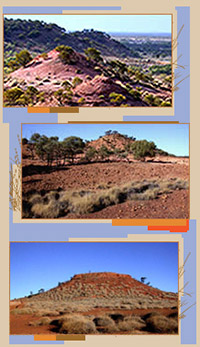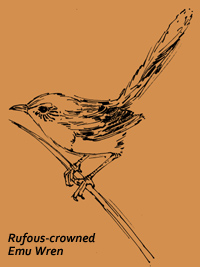The Biodiversity At Lark Quarry Conservation Park
The surrounding countryside

Lark Quarry Conservation Park is situated in Jump Up country – a landscape of mesas, gullies and steep escarpments.
This dry and dramatic landscape has been created by water. Scientists call this landscape “dissected residuals", because the sediments laid down by ancient lakes and seas have been carved over the millennia by runoff from countless summer storms.
The soils are easily eroded from around and underneath areas of 'cap rock'. This weathered and hardened rock, resistent to erosion, give the mesas their distinctive flat tops.
Climate and Rainfall
Winter: Temperatures range from 6 to 23 degrees C
Summer: Temperatures range from 35 to 42 degrees C
Rainfall: 400mm pa, most falls in the summer
Vegetation

The dominant vegetation is spinifex grass, with lancewood and Normanton box. Many small herbs flourish after summer rains.
From the lookout on the mesa behind the Trackways building, you can see Mitchell grass plains rolling away to the west and Coolibah trees growing along the watercourses. These are natural grass plains - they have not been cleared.
Further to the west is the Diamantina River and the channel country - a vast, flat plain crisscrossed by braided watercourses, many of which join during floods.
To find out more, download:
Fact Sheet 3 - 'Lark Quarry's Landscape - Jump Up Country' (306.06 KB)
Wildlife

Wildlife abounds in Lark Quarry Conservation Park, but most animals take shelter during the heat of the day. Over 90 species of birds can be seen here.
Spinifex pigeons live on seeds from spinifex and other grasses. They live in these arid lands all year round, but need access to water. On the trip out, you’ll have seen groups of black kites roosting in trees beside the road or soaring high on the thermals. They eat carrion as well as rodents, reptiles and insects. Rufous-crowned emu-wrens, weigh five grams or less, nest and shelter within the spinifex. They forage for insects in the low shrubs and tussocks.





